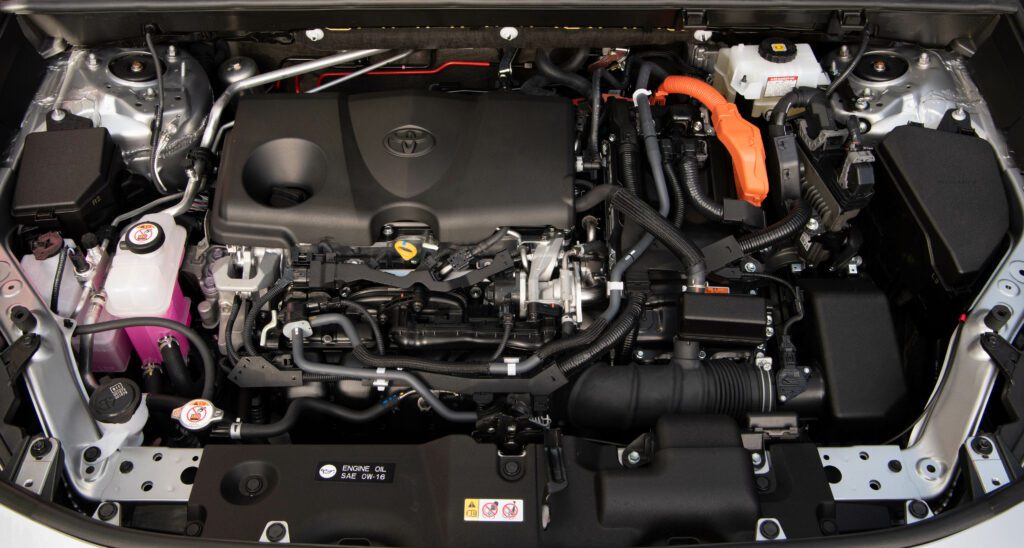How Does the Toyota RAV4 Hybrid Work?
It’s clear that the Toyota RAV4 Hybrid’s mpg is rated better than the gas-only model. Therefore, it’s natural to wonder about the inner workings of the hybrid variant. How does the Toyota RAV4 Hybrid work, and what creates the efficiency?
In this guide, I dive deeper into the RAV4 Hybrid powertrain with you. I also look at the battery and compare this model to the RAV4 Prime. By the end, you should be closer to becoming a hybrid expert.

An Overview of the RAV4 Hybrid’s Powertrain
The Toyota RAV4 contains a Nickel-Metal Hydride (Ni-MH) battery. With this hybrid battery, power doesn’t come from an external source. You can’t plug in the vehicle to charge the battery.
Instead, fuel from the engine is used to recharge the battery whenever the vehicle moves. With this setup, RAV4 replacing the RAV4 Hybrid’s battery is uncommon because the Ni-MH lasts longer than lithium-ion or lead-acid.
A hybrid vehicle has two different power sources. There’s the electric battery and the internal combustion engine. The two work together to reduce fuel consumption.

However, hybrid vehicles have varying configurations, depending on the model.
Here are two of the most common.
- Parallel Hybrid: the electric motor and gas engine connects to the transmission to produce power together
- Series Hybrid: the electric motor is paired with the transmission, providing a sole source of power, while the gas engine operates as a generator for the electric motor
The RAV4 Hybrid is considered a Parallel configuration hybrid. The battery powering it is often called the “traction battery.” This rechargeable electric vehicle battery (EVB) powers the electric motor, creating a hybrid electric vehicle (HEV).
The traction battery is the same type used in a battery electric vehicle (BEV). With this renewable energy source, power is provided to the electric motor instantaneously. This is one reason that hybrids have better fuel economy and can provide faster acceleration.
(Source)
Charging the RAV4 Hybrid’s Battery
The Toyota RAV4 Hybrid doesn’t charge as a plug-in model does. You won’t plug the RAV4 Hybrid into a charger to gain more battery power.
Instead of plugging in, the RAV4 Hybrid uses regenerative braking to charge the traction battery. The regenerative braking system transfers kinetic energy from the object in motion to stored energy for later usage.
The gas engine of the RAV4 Hybrid also charges the traction battery whenever it is running. In turn, the electric motor can use the power gained from the battery to improve efficiency.
(Source)
Differences Between the RAV4 Hybrid and RAV4 Prime
Based solely on the electric motor and battery configuration of the two, the RAV4 Hybrid doesn’t get plugged in, while the RAV4 Prime does. Instead of using an external power source for recharging, the RAV4 Hybrid relies on regenerative braking and the gas engine.
The RAV4 Hybrid also has a smaller electric battery than the Prime model. Because of this, it’s not as fuel efficient as the Prime model, nor can it travel as far on electric-only power. In EV mode, the Hybrid only travels up to 0.6 miles at very slow speeds, while the Prime can go up to 42 miles at full speeds.
The RAV4 Hybrid starting price is also lower than the Prime. Plus, it achieves 40 mpg combined, compared to the 38 mpg combined from the Prime (without a charged battery). Aside from that, the RAV4 Hybrid produces only 219 horsepower while the Prime creates 302 horsepower.
Aside from those differences, there are some similarities. Both models include the following:
- Same exterior dimensions
- High-tech infotainment and safety features
- Comparable seating configuration
Additionally, neither the RAV4 Hybrid nor the Prime qualifies for the federal EV tax credit.
Although you may have to wait a few months to pick up a new RAV4 Hybrid, it may be easier to get your hands on when compared to a RAV4 Prime. RAV4 Prime availability has proven to be challenging.
(Source)
Frequently Asked Questions
Toyota RAV4 Hybrid Models are Known for Efficiency
You don’t necessarily need to understand how the Toyota RAV4 Hybrid works to know it’s an efficient SUV. With the help of a rechargeable battery, the RAV4 Hybrid earns exceptional fuel economy ratings.
If you’re looking to go further on a tank of gas, the RAV4 Hybrid has you covered. Check this hybrid SUV out at a Toyota dealership near you.
